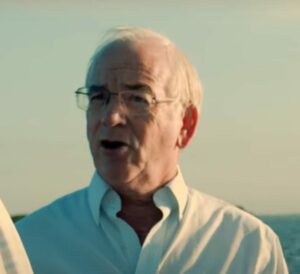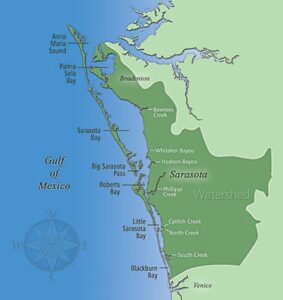‘Our Changing Environment’ talks to Dave Tomasko.
By Johannes Werner
Original Air Date: October 2, 2024
Host: Helene, Debby, and before that, another thousand-year rain event — how is Sarasota Bay holding up? The Sarasota Bay Estuary Program director talked to WSLR about the bigger environmental picture.
Johannes Werner: The Sarasota Bay estuary is one of the smallest but most densely populated estuaries in Florida – more dense than Biscayne Bay in Miami or Tampa Bay. Storm surge from Hurricane Helene flooded the barrier islands that separate the Gulf from Sarasota Bay. What effects did this have on the environmental health of the Bay? Julie Morris and Jono Miller — the hosts of the Our Changing Environment show on WSLR — yesterday interviewed Dave Tomasko, head of the Sarasota Estuary Program.
Tomasko has a fairly upbeat message about the effects of Helene.

Dave Tomasko
Dave Tomasko: It’s going to be unusual because I think Helene might be actually not as problematic as Debbie because we don’t have the big runoff, we just had storm surge. I would not go swimming on the beaches anytime soon because of all the debris, all the cars and all that other stuff. But the Bay’s water quality — if you go out on the Bay now — it doesn’t look as bad as it did after Debbie. And we’re not going to go out and sample because we don’t want to stress all the resources; We’ll gather the data as it comes in on a regular monitoring. But after Debbie and after Ian, we went out and sampled because it looked so bad. After this event, it looks really turbid, but we didn’t have the huge amount of stormwater runoff. So we’ll see, but this might be like a supercharged version of Idalia, and after Idalia, the water looked bad for a little while, but it wasn’t that bad that long. So we’ll see.
JW: The hosts and Tomasko began by talking about climate change and the need to change the way we predict our infrastructure needs.
DT: Climate change is something we’ve talked about, like in the 90s, but it’s now what we’re living through. To us, one of the big problems that we’ve tried to make people aware of is, we’ve got three major kinds of stresses: population growth, aging infrastructure, and now climate change. And climate change is making our infrastructure even more vulnerable than it would have been otherwise. So, we can’t manage our Bay based upon what worked 30 years ago, because our weather is already changing. And we’ve had two 100-year rain events in the last two years. And in June of this year, we had the highest hourly rainfall event in 50 years of record. So, you know, how often are we going to have rain events that we keep saying are so rare? They’re 100-year rain events. We’re trying to manage our infrastructure with a rainfall data set that actually doesn’t seem all that relevant anymore. And I think that’s the biggest difference in the last couple of years versus what we talked about in the nineties.
JW: The seven-foot surge this area got during Helene was made worse by the rising sea levels we’re seeing now.

The Sarasota Bay estuary
DT: We’ve got data that goes back about a hundred years and it averaged about an inch a decade; the last 20 years, it’s been three inches a decade. It appears that the rate of sea level rise is higher than what we’ve had at any time over the last two to 5,000 years. So it’s not unprecedented. 20,000 years ago, we had an even higher rate of sea level rise when we came out of the last glacial maximum. We had humans certainly on this planet hundreds of thousands of years ago, but we haven’t had like the traditionally-defined civilizations. So if you say, “Hey Siri, Hey Google, what’s the oldest civilization?” they’re going to give you the Sumerians in Mesopotamia, and that’s 5,000 years ago. And over the last 5,000 years, we’ve had sea level rise around an inch a decade. And now it’s 3 inches a decade. And so the warmer water is expanding upwards. And so it’s not even Greenland melting yet. It’s really just thermal expansion. So sea level rise is coming up, that’s a stress, more intense rain — when you combine both of those with a warmer Gulf of Mexico, warmer moisture air, that’s going to be more fuel for powerful hurricanes that are occurring, with a higher water level, with the intensity of rain increasing as well. So that’s a real stress. I’m not sure how we get through it because we’ve never gone through it before.
JW: The last rain events have triggered major sewage spills throughout the region, which promote algae growth. But Tomasko has an almost upbeat message about this, not just regarding Helene, but long term.
DT: We had quite a bit. Bradenton’s wastewater treatment plant was actually more stressed by Debby than Helene. And that’s really a function of very old infrastructure. The pipes are 50, 70 years old. Some of them are like clay, \like the pots that you put in your front yard kind-of-a-thing. But that’s actually one of the kind of good things. In 2013 to 2019, we had a billion gallons of partially treated or raw wastewater that came into our bay, mostly from Sarasota County. After Debby, I think it was down to less than a million gallons. And after this one, I’m not quite sure what we’ve had, but I get these reports and they’re not flaring up as much as they were in the past. Debby was worse than what Helene just brought us because Debby caused us more than 10 inches of rain across this huge area; it was probably hundreds of billions of gallons of rainfall and it soaks into the ground, and your pipes are like 50, 70 years old, so … it’s called infiltration inflow. So the wastewater comes through the tops of the manhole covers, but mostly what happens is the pipe is meant to be a kind of dry-ish ground. But instead, if the water table is up at the surface, if you see flooded streets, that means your ground is saturated, which means the pipes are just going to have every little crack, every little joint is going to be a way for water to get in. So Bradenton’s wastewater treatment plant had like three times as much water coming into it as what they could handle. And so the whole system kind of crashed. But you know, with Helene, we didn’t really have that much rainfall. And so we didn’t have that same stress.
JW: Tomasko highlights the importance of recent investments in local infrastructure.
DT: So these investments, our local governments have already invested over $300 million into wastewater upgrades. We had a Bobby Jones, if you’ve been there recently, that is a stormwater treatment system nature park that treats 5,000 acres of an area that didn’t have stormwater treatment. So these big stormwater retrofit projects, there’s also one in Hudson Bayou. We’ve been doing a lot of neighborhood retrofits of stormwater ponds. We’ve been doing a lot of habitat restoration projects. And so we were seeing really good trends in water quality. So over the last, say from 2020 to 2023, our water quality has improved sufficiently that in the bay … we no longer have any of the open waters of Sarasota Bay that are impaired for nutrients, which might sound weird to people, but that’s what the data shows, it’s very clear. The investments that have been made on wastewater and stormwater are paying off. The water quality is better now — it just is — than it has been, say, during the period of 2013 to 2019. So that’s good news.
JW: He cautioned that the recent weather events and the nutrients they onloaded into the Bay, and rising water temperatures, could lead to increased algae growth. He urges people to stay aware and not let loose on policymakers.
The storm reopened Midnight Pass between Siesta and Casey Key, which a growing local lobby, including environmentalists, have been clamoring for. Tomasko put it into perspective.
DT: It was open. Helene did breach that island, roughly where Midnight Pass used to be, and it stayed open for a day or two, maybe. And so, when it was open, there was a good amount of flow that was coming in and out, but I think one of the lessons there is, if you were to try to reestablish that lost historical tidal connection, even Helene — which has done hundreds of millions of dollars worth of damage to our watershed — even that wasn’t big enough to create a pass that could last more than a couple of days. So it’s a real challenge to see whether or not you could do anything that could recreate what Midnight Pass used to be, because Helene couldn’t do it.
JW: To listen to the full interview, go to WSLR dot org, click on “Archive” and look for the latest Our Changing Environment show.
WSLR News aims to keep the local community informed with our 1/2 hour local news show, quarterly newspaper and social media feeds. The local news broadcast airs on Wednesdays and Fridays at 6pm.